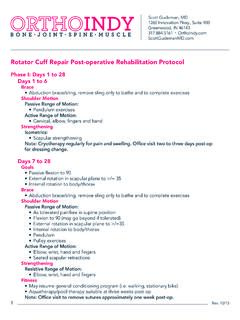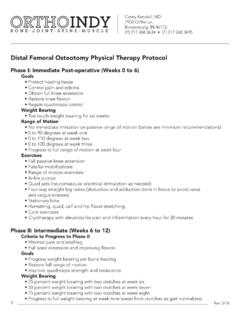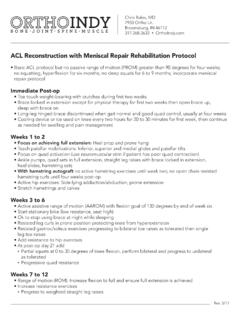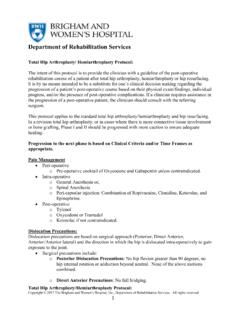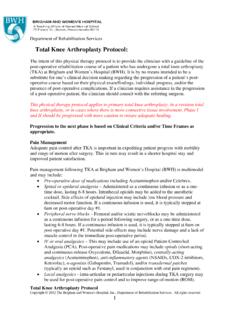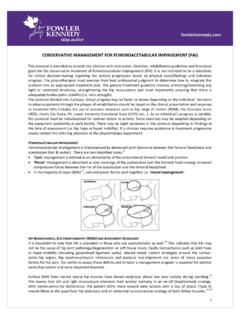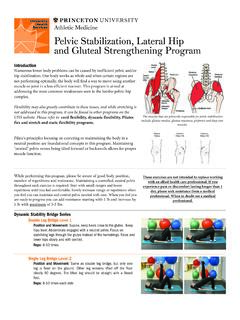Transcription of Cervical Fusion Physical Therapy Prescription
1 1 Gregory T. Poulter, MD8450 Northwest , IN 1/16 Cervical Fusion Physical Therapy PrescriptionThe intent of this protocol is to provide guidelines for rehab. It s not intended as a substitute for clinical decision any of the following occur, contact Dr. Poulter and hold off on Physical Therapy : Any signs of infection Worsening of radicular symptoms, including progressive weakness Unexpectedly high self-reports of pain in comparison to pre-surgical stateProgress patients with multi-level fusions slower and more I (0 to 6 Weeks): Protective PhaseTherapy One to two visits (if appropriate) Precautions Avoid bending, twisting, lifting, pushing and pulling 25 pounds or more for six weeks.
2 Limit sitting, including in the car, to no more than 30 minutes at a time (standing/walk breaks). No passive stretching. Gentle flexion, extension, retraction active range of motion in pain-free range only. No specific Cervical rotation or side bend active range of motion in home exercise program for 12 weeks (normal movements with activities of daily livings are okay). Bracing: 1 Level Fusion : No brace 2 Level Fusions: Four weeks 3+ Level Fusions: Six weeksGoals Diminish pain/inflammation and minimize upper extremity radiating symptoms (ice, modalities as needed).
3 Learn correct posture, body mechanics, transfers. Focus on walking program, increasing tolerance to 30 minutes, two times a Name: Diagnosis: Notes: 2 Education Postural Education: Sitting posture with lumbar roll at all times; frequent change in positions; avoid prolonged flexion (books, phones, tablets, etc.); sleeping positions Body Mechanics: Light lifting, transfers (include log rolling), positioning, etc. Driving: When off narcotic pain medicine and out of collarExercises Cardio: Zero to two weeks - walking or stationary bike two times a day, 10 minutes each to start Deep Cervical Flexors: Emphasis on neuromuscular control, 10 isometrics to start Scapular Retractions: Emphasis on neuromuscular control (eliminate shrug) Isometrics: Zero to four weeks - gentle Cervical extensions, flex, rotation, side bend Cervical Active Range of Motion.
4 Gentle, pain-free range only Light Stretching: Only pecs (eg.: supine over towel) and seated thoracic extensionsAquatic Physical Therapy (less than four weeks if available once incision has healed) Transverse abdominis bracing during all exercises and good head position. Walking all directions, balance, lower extremity strengthening (no upper extremity resistance strength until six weeks).Phase II (6 to 12 Weeks): strengthening PhaseTherapy Starting at week six, two to three times per week, four or more times a weeksPrecautions Keep spine in neutral and good posture for strengthening with a focus on proper neuromuscular control.
5 Radiographically healed at three months, progress as Patient to have proper neuromuscular control and posture with stabilization and strength exercises Initiate light strengthening and progress to independent with long term home exercise program Release soft tissue restrictions/muscle spasm/scar Body mechanics review Increase aerobic endurance to 30 minutesStrengthOnly initiate these once patient can complete Phase I exercises. Then begin with light resistance and slowly prog-ress. Emphasize good posture during each exercise and correct muscle firing of scapula stabilizers and transverse abdominis.
6 (This is not a complete list.) Postural/Scapula strengthening Prone scapula strengthening Theraband rows, extensions, external rotation, horizontal abductions, etc. Transverse abdominis isometrics first, then progression Machine rows, lat pull down (keep bar in front of head), free motion machine, etc. Cervical Postural strengthening Prone on elbows, quadruped, modified plank position with 10 retraction isometrics Swiss Ball: seated, quadruped stabilization exercises Seated retractions against Theraband Aquatic Exercises Can add upper extremity flexion/extension, upper extremity abduction/adduction, biceps, triceps, rows3 Cardio Should be continued to be done daily working up to at least 30 minutes per day (emphasis on walking or stationary bike to start.)
7 Time frames may vary per patient, consult with Dr. Poulter if you have questions (eg. an avid cyclist with proper bike fit might start sooner). Emphasize correct form and equipment setup (eg.: elliptical, bike, walking terrain, etc.). When initiating running and sports below, slowly increase in the four to six month time Stretching: Pecs, thoracic extensions Neural Mobilization: Performed as needed, gentle with caution not to flare up nerve roots Cervical Active Range of Motion: Gentle, no overpressure Manual Therapy Soft tissue mobilization, joint mobilization on non-operative joints as neededPhase III (12+ Weeks).
8 Return to Work/Work Conditioning/ Return to Sport (if applicable) No aggressive rotation or side bend range of motion Functional/sport/job drills may begin now with supervision Possible referral to work reconditioning programNo Earlier Than:Walking ProgressionAt least 30 minutes a dayStationary BikeTwo weeksEllipticalFour weeksHikingFour weeksPilates (Neutral Spine)Four weeksRunning6 to 12 weeksNo Earlier Than:YogaThree monthsOutdoor BikingThree monthsSwimmingThree monthsSkiingFour monthsGolfFour to six monthsSoccer/BasketballFour to six months

